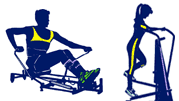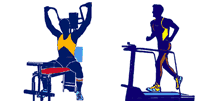|
GYM PULLEYS
The pulleys on home gyms or commercial strength equipment are used every time a selectorized weight stack is lifted, yet they are often taken for granted and neglected.
Some gym pulleys are made of plastic and have a bushing
in the center where the support bolt passes through, but better pulleys are
made of fiber glass reinforced nylon and have bearings in the center. Most
of the better gym pulleys last for years and require no preventive maintenance
other than inspection.
They sometimes get chipped, cracked or chewed up at
the outside edges. These deformities usually are a result of misuse of the
equipment and allowing the weight stack to come too far up the guide rods
and come into contact with the pulley. Over a period of time, the roller
bearings built into the center of the pulley can wear out, causing a rough
feel to the weight movement or making the pulley wobble. A wobbly pulley
can cause a cable to derail and get damaged.
Sometimes, with wear, the channel in the pulley, where
the cable rides, gets rough and can ruin the sheathing on the gym cable.
This is most often caused by using the pulley with a partially frayed cable
or one that is missing part of its sheath.
Inspect your gym's pulleys for damage or wear. If
you find any defects, replace the defective pulley before it damages the
associated gym cable.
If you need to find a replacement pulley, knowing the
brand and model of the gym that the pulley is on will help you to get the
correct replacement, but frequently, by the time the pulleys wear out the
gym manufacturer is out of business. If that is the case when you are ready
to order a replacement gym pulley, you will need to know three things about
the pulley: the diameter, the bore ( basically, what size bolt passes through
the hole in the center) and approximately how wide the pulley is at the center.
|





